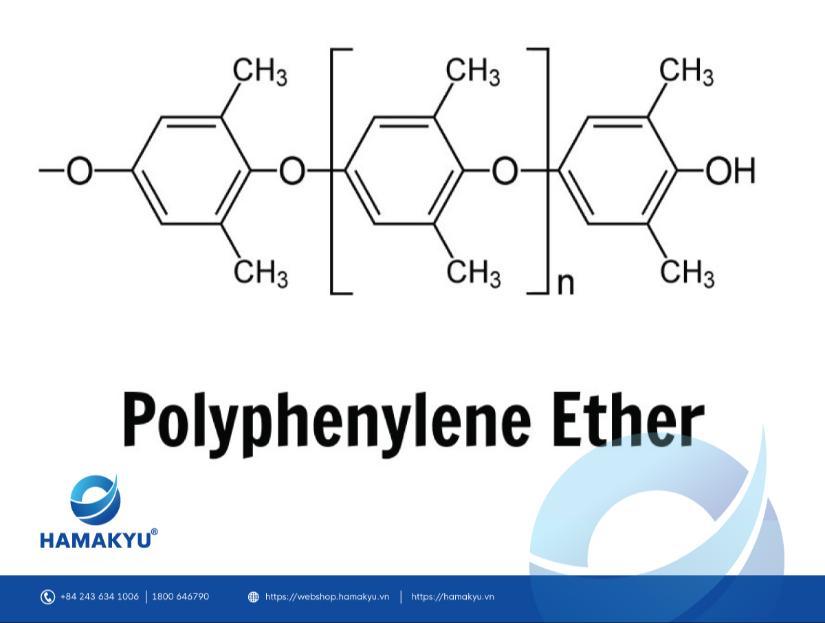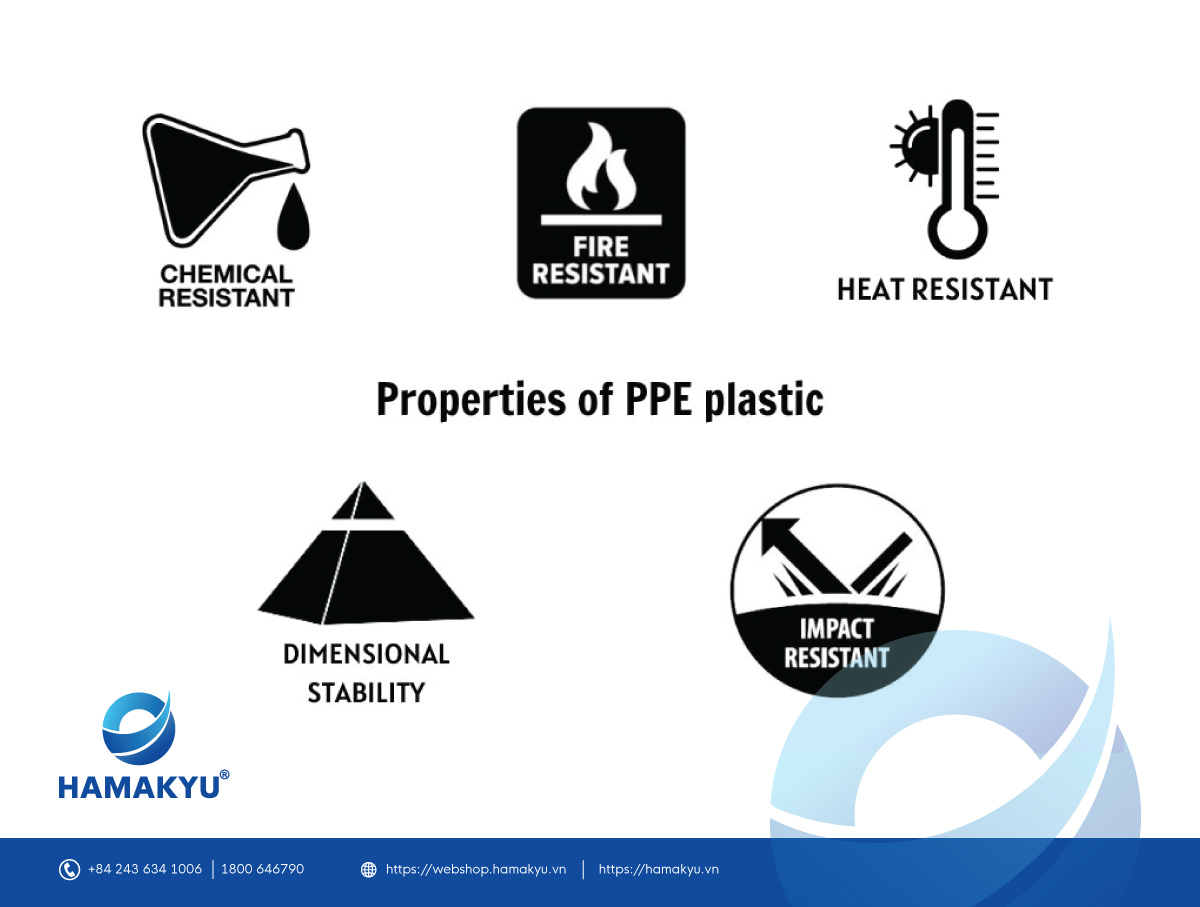1. Nhựa PPE là gì?
PPE hay polyphenylene ether là một loại nhựa nhiệt dẻo cao cấp được phát hiện lần đầu vào năm 1959 bởi Allan Hay và được đưa vào khai thác thương mại chỉ một năm sau đó bởi General Electric. Trong một số trường hợp, nhựa PPE còn được gọi với một cái tên khác là PPO (Polyphenylene oxide) hay tên hóa học đầy đủ Poly(2,6-dimethyl-1,4-phenylene ether).
Nhựa PPE vẫn thường được biết đến là một loại polymer nhựa kỹ thuật có khả năng chịu nhiệt, ổn định kích thước và tính chất cơ học tuyệt vời. Cũng nhờ đó mà nhựa PPE được sử dụng cho nhiều mục đích khác nhau, đặc biệt là trong ngành công nghiệp sản xuất.
Tổng quan, nhựa PPE là một loại vật liệu đa dụng cung cấp sự kết hợp của các đặc tính cơ học, nhiệt, hóa học và điện xuất sắc. Hãy cùng EuroPlas khám phá chi tiết từng thuộc tính và ứng dụng của nhựa PPE trong các phần tiếp theo của bài viết.

2. Thuộc tính của nhựa PPE ?
Việc hiểu rõ các đặc tính của nhựa PPE (Polyphenylene ether) sẽ giúp bạn tận dụng tối đa lợi ích mà loại vật liệu nhựa này mang lại. Thứ nhất, nhựa PPE thể hiện khả năng chịu nhiệt đặc biệt bởi nó có thể tồn tại môi trường nhiệt độ cao mà không bị biến đổi tính chất cơ học ban đầu.
Thứ hai, nhựa PPE sở hữu tính năng kháng hóa chất vượt trội với khả năng chịu được axit, bazơ và dung môi. Thêm vào đó, nhựa PPE có tính ổn định kích thước, điều này đảm bảo hình dạng và kích thước của loại vật liệu này luôn nhất quán dù trải qua các điều kiện khác nhau.
Nhựa PPE cũng được biết đến với đặc tính chống cháy mang lại sự an toàn cao hơn trong các tình huống liên quan đến nguy cơ hỏa hoạn. Ngoài ra, nhựa PPE cũng là một chất cách điện lý tưởng cho các ứng dụng trong ngành công nghiệp điện tử.
Ngoài ra, khả năng chống va đập vượt trội giúp nhựa PPE trở thành một loại vật liệu siêu bền bỉ có khả năng chịu được các tác động ngoại lực. Những đặc tính này làm cho nhựa PPE trở thành một loại vật liệu nổi bật với tính linh hoạt, độ tin cậy cao và có giá trị đối với nhiều ngành công nghiệp khác nhau.
Tuy nhiên, nhựa PPE cũng có những mặt hạn chế nhất định. Đầu tiên, nhựa PPE có độ nhớt cao, điều này có thể gây ra các khó khăn trong quá trình gia công và đúc sản phẩm từ nhựa này.
Cuối cùng, giá thành của nhựa PPE cũng có thể được coi là một nhược điểm. So với một số loại vật liệu nhựa khác, nhựa PPE có giá cả cao hơn, điều này có thể là một rào cản trong việc sử dụng cho những ứng dụng có ngân sách hạn chế.

3. Ứng dụng của nhựa PPE
Nhựa PPE được ứng dụng trong các ngành công nghiệp khác nhau tương ứng với tính năng và ưu điểm vượt trội của loại vật liệu này. Trong lĩnh vực sản xuất linh kiện ô tô và hàng không vũ trụ, nhựa PPE được sử dụng cho ống nạp khí, nắp van, chi tiết động cơ và các bộ phận bên dưới mui xe bởi khả năng chịu nhiệt cao, ổn định kích thước và kháng hóa chất.

Trong ngành điện và điện tử, nhựa PPE thường được tìm thấy trong các thiết bị đóng cắt, cầu dao, đầu nối và vỏ ổ cắm. Cũng bởi tính năng chống cháy và cách điện, nhựa PPE được sử dụng trong các sản phẩm đồ gia dụng, linh kiện máy rửa bát hay một số thiết bị nhà bếp khác.
Đối với các thiết bị công nghiệp, độ bền và khả năng kháng hóa chất của nhựa PPE cho phép nó được sử dụng để xử lý chất lỏng ăn mòn thường được tìm thấy trong máy bơm, van và hệ thống lọc. Thêm vào đó, nhựa PPE còn đóng vai trò quan trọng trong việc sản xuất các dụng cụ cụ phẫu thuật, đầu nối IV và các thiết bị chuẩn đoán giúp nâng cao chất lượng chăm sóc sức khỏe cộng đồng.
Những ứng dụng đa dạng của nhựa PPE đã chứng tỏ được tính linh hoạt và độ tin cậy cao trong nhiều ngành công nghiệp khác nhau. Không những vậy, ứng dụng của nhựa PPE đang ngày càng mở rộng cùng với những tiến bộ mới, từ đó biến loại vật liệu này trở thành một sự lựa chọn tối ưu đối với các doanh nghiệp hay các nhà sản xuất.
Để được tư vấn và tìm hiểu thông tin chi tiết về sản phẩm, vui lòng liên hệ!
Khám phá thêm thông tin hữu ích tại đây!





